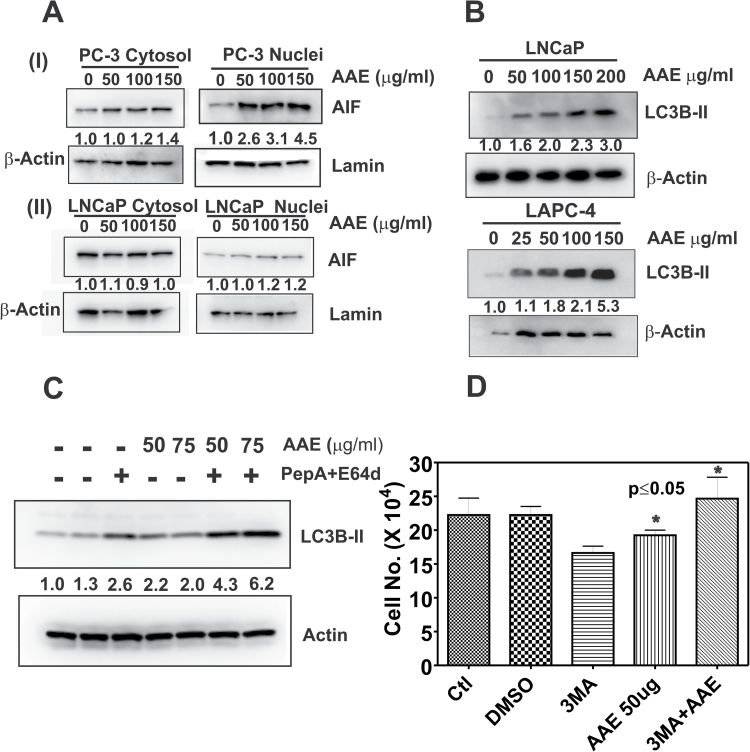Fig. 3.
AAE induces apoptosis and autophagy in CaP cells. (A) Effect of AAE on AIF protein levels in (I) PC-3 and (II) LNCaP cells. Cells were treated with several concentrations of AAE for 24 h. Cytosol and nuclear fractions were prepared using a kit (Thermo Fisher Scientific, Pittsburgh, PA). Total proteins were estimated in each nuclear and cytoplasmic fraction using the BCA reagent (Bio-Rad) and equal amount of proteins were mixed with 2× sodium dodecyl sulfate–gel sample buffer and analyzed by western blotting. Blots were re-probed with β-actin and nuclear lamin to normalize for loading controls for cytoplasmic and nuclear fractions, respectively. Numbers shown below the blots are density of the protein blots normalized to that of untreated controls. (B) AAE induced autophagy in LNCaP and LAPC-4 cells. Cell lysates from LNCaP and LAPC-4 cells treated with AAE for 24 h were analyzed by immunoblotting. Blots were probed for membrane-bound form of LC3B (LC3B-II) using a specific antibody (Cell Signaling, Danvers, MA). A significant dose-dependent increase in LC3B-II (shown as the ratio of LC3B-II to β-actin below the blots) occurred following AAE treatment. (C) Specific increase in membrane-bound LC3B-II following AAE treatment in LAPC-4 cells. Cells were exposed to lysosomal protease inhibitors pepstatin A and E64D (PepA/E64D) for 4 h and LC3B-II levels were analyzed by immunoblotting. As PepA/E64D combination inhibited lysosomal degradation of LC3B-II, increased accumulation of LC3B-II resulting from AAE-induced autophagy flux was observed. (D) Inhibition of autophagy by 3-MA decreases AAE cytotoxicity in LAPC-4 cells. LAPC-4 cells were pretreated with 3-MA, an inhibitor of PI3K that drives autophagy. Cytotoxicity of AAE on LAPC-4 cells, treated with AAE (50 µg/ml) alone or with 3-MA (an inhibitor of autophagy) for 48 h, were estimated by cell counting. Data shown are mean ± SEM. Significant decrease in the efficacy of AAE was observed in the presence of 3-MA (P ≤ 0.05).

